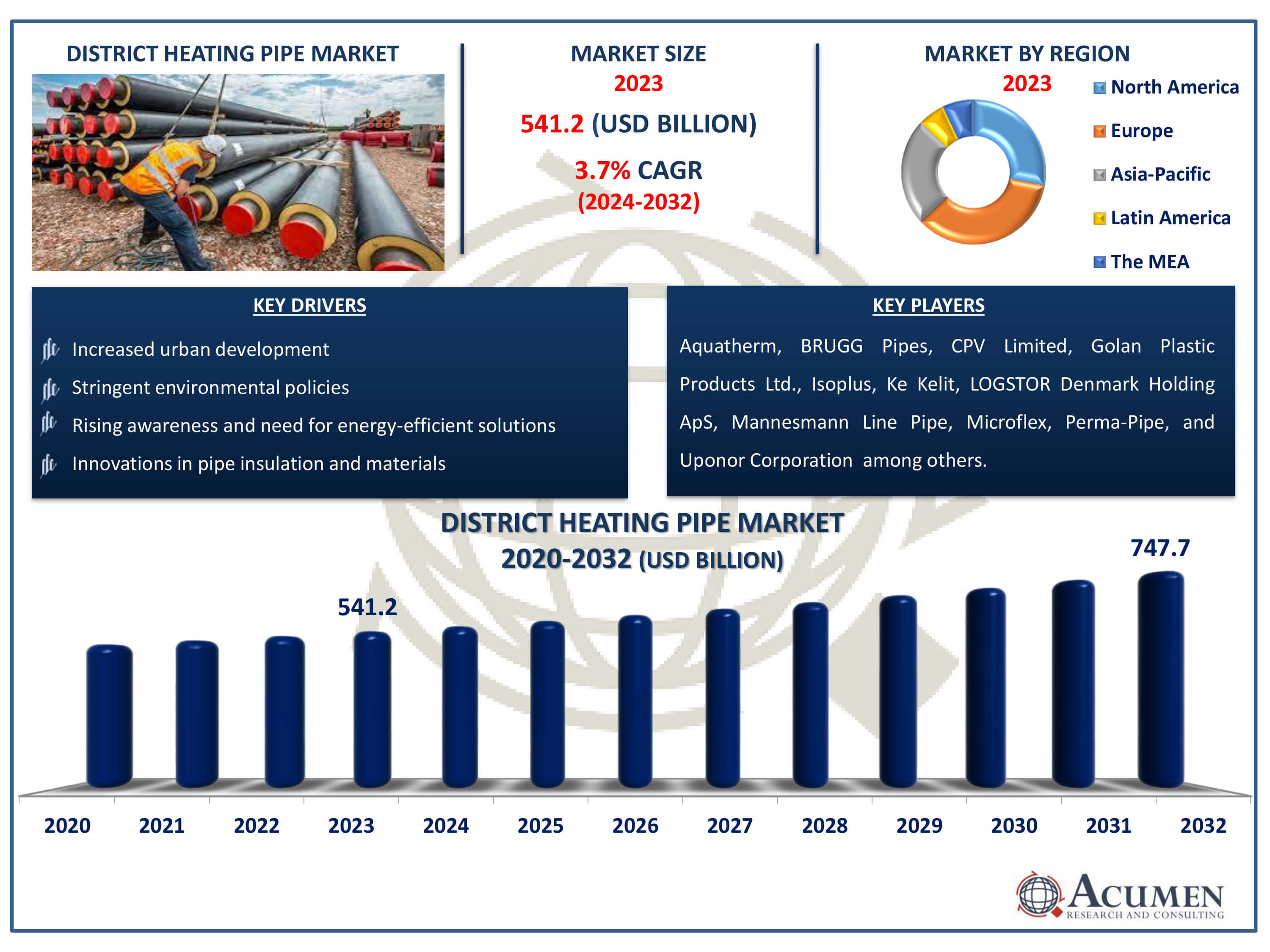District Heating Pipe Market Size - Global Industry, Share, Analysis, Trends and Forecast 2024 - 2032
Published :
Report ID:
Pages :
Format :
District Heating Pipe Market Size - Global Industry, Share, Analysis, Trends and Forecast 2024 - 2032
Report Coverage
- Industry Dynamics
- Market Size and Forecast Data
- Segment Analysis
- Competitive Landscape
- Regional Analysis with a Niche Focus on Country-Level Data
- High Level Analysis - Porter's, PESTEL, Value Chain, etc.
- Company Profiles of Key Players
- Option to Customize the Report As Per Your Specific Need
Request Sample Report
The District Heating Pipe Market Size accounted for USD 541.2 Billion in 2023 and is estimated to achieve a market size of USD 747.7 Billion by 2032 growing at a CAGR of 3.7% from 2024 to 2032.
District Heating Pipe Market Highlights
- Global district heating pipe market revenue is poised to garner USD 747.7 billion by 2032 with a CAGR of 3.7% from 2024 to 2032
- Europe district heating pipe market value occupied around USD 189.4 billion in 2023
- North America district heating pipe market growth will record a CAGR of 5% from 2024 to 2032
- Among pipe, the pre-insulated steel sub-segment gathered USD 297 billion in revenue in 2023
- Based on diameter, the 101-300 nm sub-segment occupied 46% market share in 2023
- Increasing integration of smart technology and digitalization is a popular district heating pipe market trend that fuels the industry demand

District heating pipes play a crucial role in district heating systems, which supply centralized heat to multiple buildings within a defined area, such as a neighborhood, campus, or city district. These pipes transport hot water or steam from a central heat source, like a combined heat and power plant, geothermal well, or industrial waste heat recovery system, to various end-users. The system comprises a network of supply and return pipes: supply pipes carry the heated fluid to the buildings, while return pipes bring the cooled fluid back to the central plant for reheating. Insulation is typically applied to the pipes to minimize heat loss during transmission, ensuring efficient energy use and reliable service.
The selection and Industrial of district heating pipes are critical factors in ensuring their reliability and longevity. Contemporary district heating pipes are often engineered with advanced features, including multiple layers of polyurethane foam insulation and protective casings made from materials like polyethylene or steel. This design enables the efficient retention of temperature and safeguards the pipes against external damage, environmental factors, and thermal stress caused by temperature fluctuations. The performance and efficiency of district heating systems heavily rely on the quality of these pipes, as they must be capable of withstanding high temperatures, pressure variations, and thermal expansion and contraction. By harnessing centralized heat production and leveraging cutting-edge technologies, district heating systems with robust pipe networks can significantly reduce greenhouse gas emissions and promote urban energy sustainability.
Global District Heating Pipe Market Dynamics
Market Drivers
- Increased urban development drives the demand for efficient district heating systems
- Stringent environmental policies promote the adoption of district heating to reduce carbon emissions
- Rising awareness and need for energy-efficient solutions
- Innovations in pipe insulation and materials enhance the efficiency and reliability of district heating systems
Market Restraints
- Significant upfront costs for installation and infrastructure development
- Complexities in retrofitting existing urban infrastructures
- Ongoing maintenance and potential repair costs can pose financial burdens for district heating networks
Market Opportunities
- Subsidies and incentives for sustainable energy projects
- Growing urban areas in developing countries
- Opportunities to integrate district heating systems with renewable energy sources like geothermal and solar thermal
District Heating Pipe Market Report Coverage
| Market | District Heating Pipe Market |
| District Heating Pipe Market Size 2022 | USD 541.2 Billion |
| District Heating Pipe Market Forecast 2032 |
USD 747.7 Billion |
| District Heating Pipe Market CAGR During 2023 - 2032 | 3.7% |
| District Heating Pipe Market Analysis Period | 2020 - 2032 |
| District Heating Pipe Market Base Year |
2022 |
| District Heating Pipe Market Forecast Data | 2023 - 2032 |
| Segments Covered | By Pipe, By Diameter, By Application, And By Geography |
| Regional Scope | North America, Europe, Asia Pacific, Latin America, and Middle East & Africa |
| Key Companies Profiled | Aquatherm, BRUGG Pipes, CPV Limited, Golan Plastic Products Ltd., Isoplus, Ke Kelit, LOGSTOR Denmark Holding ApS, Mannesmann Line Pipe, Microflex, Perma-Pipe, PIPELIFE INTERNATIONAL, REHAU, Thermaflex, and Uponor Corporation. |
| Report Coverage |
Market Trends, Drivers, Restraints, Competitive Analysis, Player Profiling, Covid-19 Analysis, Regulation Analysis |
District Heating Pipe Market Insights
The district heating pipe market is experiencing rapid growth, fueled by several key factors. A primary driver of this growth is the global trend of urbanization, which is leading to an increased demand for efficient and reliable heating solutions in densely populated areas. As cities continue to expand, the need for sustainable and centralized heating systems becomes increasingly pressing, driving the adoption of district heating networks. Additionally, stringent environmental regulations and policies aimed at reducing carbon emissions are prompting municipalities and industries to invest in district heating systems. These systems are well-positioned to meet environmental goals due to their ability to harness waste heat and renewable energy sources, making them an attractive option for organizations seeking to reduce their environmental footprint.
Technological advancements are pivotal in propelling the district heating market forward. Breakthroughs in pipe insulation materials and Industrial methods have significantly boosted the efficiency and durability of district heating pipes. Contemporary pipes are engineered to minimize heat loss during transmission, thereby enhancing the overall energy efficiency of the system. These innovations also reduce maintenance costs and extend the lifespan of the infrastructure, making district heating systems a more cost-effective and reliable option over the long term. Furthermore, the integration of smart technologies for monitoring and managing heat distribution networks further optimizes system performance and user satisfaction, driving increased adoption and growth in the market.
Despite its promising growth prospects, the district heating pipe market is not without its challenges. One significant restraint is the high initial investment required to establish district heating networks, which can be a major obstacle in regions with limited budgets. Furthermore, the complexity of retrofitting existing urban infrastructure to accommodate new district heating systems can be a hurdle, necessitating extensive planning and coordination efforts. Moreover, the ongoing maintenance and potential repair costs associated with district heating pipes can be a financial burden, particularly for older systems that may require more frequent upkeep. These challenges can limit the widespread adoption of district heating systems and hinder the growth of the market.
Recent developments in the district heating industry suggest a promising trend towards overcoming existing challenges and capitalizing on emerging opportunities. Governments worldwide are introducing subsidies and incentives to promote the adoption of district heating systems as part of their sustainable energy strategies. For instance, several European countries have launched initiatives to expand their district heating networks, backed by substantial funding and supportive policies. Meanwhile, emerging markets in Asia and Latin America are witnessing increased investment in district heating infrastructure, driven by urbanization and economic growth. Furthermore, the integration of renewable energy sources, such as geothermal and solar thermal, into district heating systems presents a significant opportunity. This integration not only enhances the sustainability of district heating networks but also aligns with global efforts to transition towards cleaner energy sources. As a result, the district heating industry is poised for growth, driven by a convergence of technological innovation, government support, and environmental concerns.
District Heating Pipe Market Segmentation
The worldwide market for district heating pipe is split based on pipe, diameter, application, and geography.
District Heating Pipe Market By Pipe
- Pre-Insulated Steel
- Polymer
According to the district heating pipe industry analysis, the market is predominantly dominated by pre-insulated steel pipes. Pre-insulated steel pipes are favored due to their superior durability, strength, and thermal insulation properties. They are designed to withstand high temperatures and pressures, making them particularly suitable for large-scale and high-demand district heating networks. The robust Industrial of steel pipes ensures long-term reliability and minimal maintenance, which are critical factors for the efficient operation of district heating systems. Additionally, advancements in insulation technologies have further enhanced the performance and energy efficiency of pre-insulated steel pipes, solidifying their position as the preferred choice in the district heating pipes market.
District Heating Pipe Market By Diameter
- 20-100 nm
- 101-300 nm
- Above 300 nm
The district heating pipe market is characterized by a strong presence of pipes with diameters between 101-300 nanometers. This size range has proven to be a sweet spot, balancing the need for sufficient capacity to transport large volumes of hot water or steam with practical considerations such as installation and maintenance. Pipes within this diameter range offer versatility and suitability for a wide range of urban and suburban applications, effectively meeting the heating needs of both residential and commercial properties. Their widespread adoption is attributed to their ability to efficiently meet the demands of medium to large-scale district heating networks, ensuring optimal flow rates, effective heat transfer, and manageable installation and operational costs.
District Heating Pipe Market By Application
- Residential
- Commercial
- College/University
- Office Buildings
- Government/Military
- Other
- Industrial
- Chemical
- Refinery
- Paper
- Other
According to the district heating pipe market forecast, the residential application is expected to lead the market throughout 2024 to 2032. This dominance is attributed to the widespread implementation of district heating systems in urban residential areas, where centralized heating solutions provide a cost-effective and energy-efficient way to meet the heating needs of densely populated neighborhoods. The growing trend of urbanization and the push for sustainable living environments further drive the adoption of district heating in residential applications. Additionally, government initiatives and policies aimed at reducing carbon emissions and promoting energy efficiency in residential buildings contribute to the strong demand in this segment.
District Heating Pipe Market Regional Outlook
North America
- U.S.
- Canada
Europe
- U.K.
- Germany
- France
- Spain
- Rest of Europe
Asia-Pacific
- India
- Japan
- China
- Australia
- South Korea
- Rest of Asia-Pacific
Latin America
- Brazil
- Mexico
- Rest of Latin America
The Middle East & Africa
- South Africa
- GCC Countries
- Rest of the Middle East & Africa (ME&A)

District Heating Pipe Market Regional Analysis
The district heating pipe market displays significant regional disparities, with Europe emerging as the global leader. The continent's strong presence is largely attributed to the widespread adoption of district heating systems in Scandinavian and Eastern European countries, which has been driven by stringent environmental regulations, high energy efficiency standards, and substantial government support through subsidies and incentives. Countries like Denmark, Sweden, and Germany have established robust district heating networks that are continuously being expanded and upgraded. The European Union's efforts to reduce greenhouse gas emissions and enhance energy security have also fueled the growth of the district heating pipe market in the region. Additionally, technological advancements and a strong commitment to sustainability have further solidified Europe's position as a dominant player in this district heating pipline network market.
In contrast, the district heating pipes market in North America and Asia-Pacific is evolving at a different pace and under distinct conditions. In North America, the United States and Canada are witnessing a growing interest in district heating, particularly in urban areas and university campuses, where centralized heating can offer significant cost and energy savings. However, the district heating pipline network market is less mature compared to Europe, with fewer extensive networks in place. On the other hand, the Asia-Pacific region, led by China and South Korea, is experiencing rapid growth driven by urbanization, economic development, and a growing focus on sustainable energy solutions. Governments in these countries are heavily investing in district heating infrastructure to reduce pollution and enhance energy efficiency in urban areas. This regional analysis underscores the varying stages of market development and the diverse factors driving growth in different parts of the world.
District Heating Pipe Market Players
Some of the top district heating pipe companies offered in our report includes Aquatherm, BRUGG Pipes, CPV Limited, Golan Plastic Products Ltd., Isoplus, Ke Kelit, LOGSTOR Denmark Holding ApS, Mannesmann Line Pipe, Microflex, Perma-Pipe, PIPELIFE INTERNATIONAL, REHAU, Thermaflex, and Uponor Corporation.
Frequently Asked Questions
How big is the district heating pipe market?
The district heating pipe market size was valued at USD 541.2 billion in 2023.
What is the CAGR of the global district heating pipe market from 2024 to 2032?
The CAGR of district heating pipe industry is 3.7% during the analysis period of 2024 to 2032.
Which are the key players in the district heating pipe market?
The key players operating in the global market are including Aquatherm, BRUGG Pipes, CPV Limited, Golan Plastic Products Ltd., Isoplus, Ke Kelit, LOGSTOR Denmark Holding ApS, Mannesmann Line Pipe, Microflex, Perma-Pipe, PIPELIFE INTERNATIONAL, REHAU, Thermaflex, and Uponor Corporation.
Which region dominated the global district heating pipe market share?
Europe held the dominating position in district heating pipe industry during the analysis period of 2024 to 2032.
Which region registered fastest CAGR from 2024 to 2032?
North America region exhibited fastest growing CAGR for market of district heating pipe during the analysis period of 2024 to 2032.
What are the current trends and dynamics in the global district heating pipe industry?
The current trends and dynamics in the district heating pipe industries include increased urban development drives the demand for efficient district heating systems, stringent environmental policies promote the adoption of district heating to reduce carbon emissions, and rising awareness and need for energy-efficient solutions.
Which pipe held the maximum share in 2023?
The pre-insulated steel held the maximum share of the district heating pipe industry.


